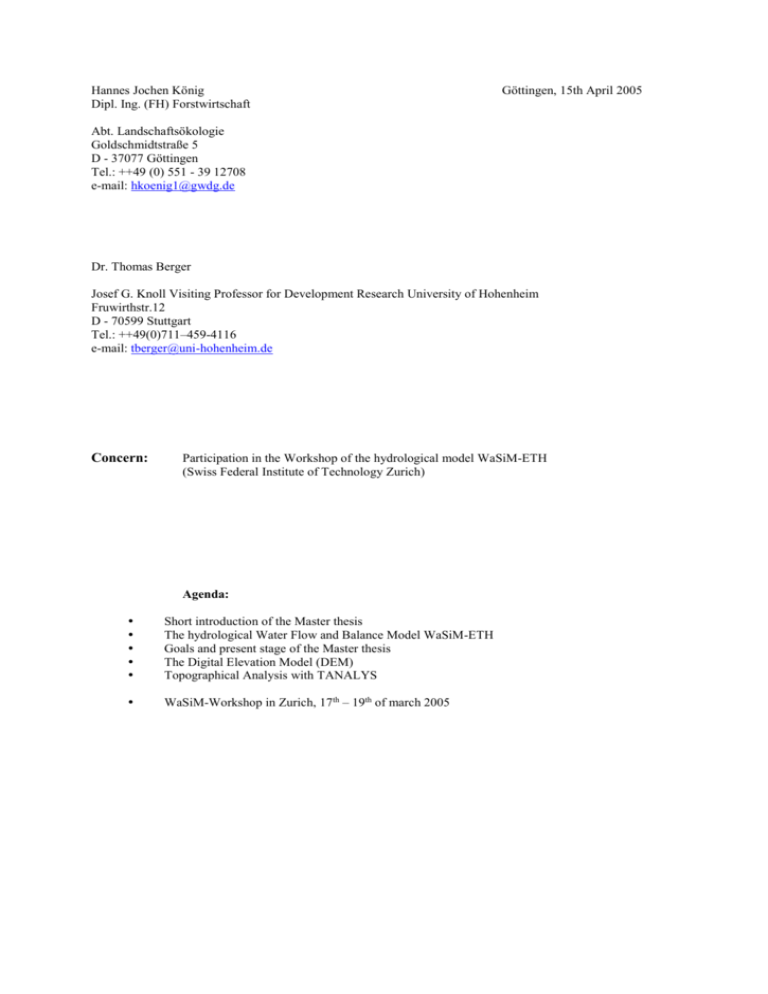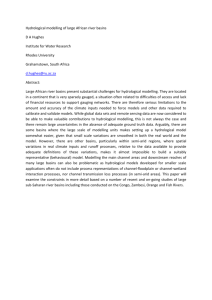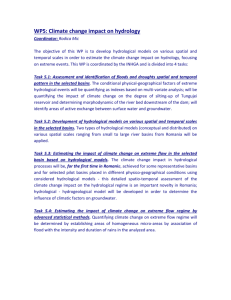modelling elevations
advertisement

Hannes Jochen König Dipl. Ing. (FH) Forstwirtschaft Göttingen, 15th April 2005 Abt. Landschaftsökologie Goldschmidtstraße 5 D - 37077 Göttingen Tel.: ++49 (0) 551 - 39 12708 e-mail: hkoenig1@gwdg.de Dr. Thomas Berger Josef G. Knoll Visiting Professor for Development Research University of Hohenheim Fruwirthstr.12 D - 70599 Stuttgart Tel.: ++49(0)711–459-4116 e-mail: tberger@uni-hohenheim.de Concern: Participation in the Workshop of the hydrological model WaSiM-ETH (Swiss Federal Institute of Technology Zurich) Agenda: Short introduction of the Master thesis The hydrological Water Flow and Balance Model WaSiM-ETH Goals and present stage of the Master thesis The Digital Elevation Model (DEM) Topographical Analysis with TANALYS WaSiM-Workshop in Zurich, 17th – 19th of march 2005 Master thesis: Title and subject of this Master thesis is the “Impact of different land use systems on the water availability in four sub basins in Chile”. The thesis is part of the Master program “Master of Science in Tropical Agriculture” of the Georg-August University, Göttingen, Germany. The investigation area is located in Chile, approximately 300 km south of Santiago de Chile between Talca and Linares. During a four month stay in Chile (October 2004 to February 2005), extensive sets of data have been collected. The Master thesis is embedded in a current challenge program: Integrating Governance and Modelling within the CGIAR Challenge Program on Water and Food. Water Flow and Balance Simulation Model, WaSiM-ETH Main tool of this Master thesis is a modelling approach by using the “Water Flow and Balance Simulation Model” WaSiM-ETH. This hydrological model is able to calculate the amount and time distribution of runoff for a basin out of known topography data (digital elevation model), land use and soil consistence, meteorological station data like precipitation, temperature etc.. Processes like evapotranspiration, water interception, infiltration and water storage capacity are considered. They depend on the current land use conditions which effect directly the runoff. Goals and present stage of the Master thesis WaSiM-ETH enables to identify and specify certain impact factors on the runoff which will be investigated by this Master thesis. A base line study and a sensitivity analysis of the impact of different land use systems on the water availability in four selected sub basins will be carried out. Collected sets of data were evaluated and missing data was requested or completed. Before using data for the modelling, pre-processing has to be carried out in order to convert the data into the demanded format. In this case most had to be converted from an excel format into an ASCII format. Digital Elevation Model One of the most important requirement for the work with the WaSiM-ETH hydrological model is a Digital Elevation Model (DEM), especially in mountainous regions, with high precision in the investigated area. It includes local information such as slope, elevation, stream network, flow direction or flow accumulations (e.g.). The demanded DEM had been developed with the cooperation of the Department of Landscape Ecology at the Institute of Geography, University of Göttingen. Data was extracted from the SRTM (‘Shuttle Radar Topography Mission’) internet side (ftp://e0mss21u.ecs.nasa.gov/srtm/) of the NASA (‘National Aeronautics and Space Administrations’). Further development of the DEM was carried out with a GIS (Geography Information System, Here: SAGA ‘System for Automated Geoscientific Analyses’) and converted into the raster unit of 100 meters. Topographical Analysis TANALYS (`Topography Analysis’) is a control file which includes all information required for the topographical analysis of the DEM. If TANALYS is started by setting all parameters ‘on’, a complete topographical analysis generates a series of output grids. Such grids were imported into a GIS (Arc View 3.2a) to illustrate the stream network and delineate the sub basins. Further steps: - Creation of ‚output grids’ for the sub-basins (micro cuencas) with TANALYS. Six sub basins were determined with a total size of 669.29 km². - Completing of missing meteorological data sets and converting of available data sets into the demanded WaSiM format. - Integration of the digital soil map and the digital land use map into the hydrological model WaSiM. Next steps: - Regionalisierung der Temperatur und Niederschläge / Gebietsniederschlag (Höhenregression) - Erstellen der Abflußdateien für WASIM - Festlegen der Evapotranspirations Parameter WaSiM-Workshoph in Zurich, 17th – 19th of march 2005 The WaSiM workshop took place at the Swiss Federal Institute of Technology of Zurich (ETH). After a short reception and opening session of the Workshop the model developer (J. Schulla) introduced briefly himself and the hydrological model WaSiM. The following agenda of the workshop will give an overview of certain topics, which were included into the workshop: Introduction and overview into the hydrological model WaSiM as well as a presentation of its current stage of development Exchange of collected experiences by WaSiM users: Lectures and poster presentations Collective discussions of questions, further maintenance, model extension, service and support approaches Development and introduction of an internet platform for WaSiM users Personal contacts between model users and network building The WaSiM workshop was divided into parts where the WaSiM model was introduced and explained, one part with various presentations by different model users of case studies and finally a visit of the hydrological research area of the ETH in the Rietholzbach, Thur-Rhein basin. All participants had the chance to get an extensive introduction of the hydrological model WaSiM-ETH. A users network was build up within personal contacts and an internet platform. Several subgroups of model users were formed in order to exchange experiences and questions within certain topics.







